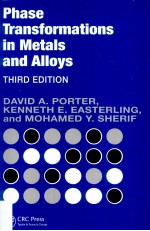

Phase Transformations in Metals and Alloys THIRD EDITIONPDF电子书下载
- 电子书积分:16 积分如何计算积分?
- 作 者:DAVID A.PORTER
- 出 版 社:LLC
- 出版年份:2009
- ISBN:9781420062106
- 页数:520 页
1 Thermodynamics and Phase Diagrams 1
1.1 Equilibrium 1
1.2 Single Component Systems 4
1.2.1 Gibbs Free Energy as a Function of Temperature 4
1.2.2 Pressure Effects 7
1.2.3 The Driving Force for Solidification 9
1.3 Binary Solutions 11
1.3.1 The Gibbs Free Energy of Binary Solutions 11
1.3.2 Ideal Solutions 13
1.3.3 Chemical Potential 16
1.3.4 Regular Solutions 17
1.3.5 Activity 21
1.3.6 Real Solutions 23
1.3.7 Ordered Phases 24
1.3.8 Intermediate Phases 26
1.4 Equilibrium in Heterogeneous Systems 29
1.5 Binary Phase Diagrams 31
1.5.1 A Simple Phase Diagram 32
1.5.2 Systems with a Miscibility Gap 33
1.5.3 Ordered Alloys 34
1.5.4 Simple Eutectic Systems 34
1.5.5 Phase Diagrams Containing Intermediate Phases 35
1.5.6 The Gibbs Phase Rule 35
1.5.7 The Effect of Temperature on Solid Solubility 40
1.5.8 Equilibrium Vacancy Concentration 41
1.6 The Influence of Interfaces on Equilibrium 43
1.7 Ternary Equilibrium 46
1.8 Additional Thermodynamic Relationships for Binary Solutions 51
1.9 Computation of Phase Diagrams 53
1.9.1 Pure Stoichiometric Substances 54
1.9.2 Solution Phases 57
1.9.2.1 Substitutional Solutions 57
1.10 The Kinetics of Phase Transformations 59
References 60
Further Reading 60
Exercises 61
2 Diffusion 65
2.1 Atomic Mechanisms of Diffusion 66
2.2 Interstitial Diffusion 69
2.2.1 Interstitial Diffusion as a Random Jump Process 69
2.2.2 Effect of Temperature-Thermal Activation 72
2.2.3 Steady-State Diffusion 74
2.2.4 Nonsteady-State Diffusion 75
2.2.5 Solutions to the Diffusion Equation 76
2.3 Substitutional Diffusion 80
2.3.1 Self-Diffusion 80
2.3.2 Vacancy Diffusion 85
2.3.3 Diffusion in Substitutional Alloys 87
2.3.4 Diffusion in Dilute Substitutional Alloys 96
2.4 Atomic Mobility 96
2.5 Tracer Diffusion in Binary Alloys 99
2.6 Diffusion in Ternary Alloys 101
2.7 High-Diffusivity Paths 103
2.7.1 Diffusion along Grain Boundaries and Free Surfaces 103
2.7.2 Diffusion along Dislocations 107
2.8 Diffusion in Multiphase Binary Systems 108
References 110
Further Reading 111
Exercises 111
3 Crystal Interfaces and Microstructure 115
3.1 Interfacial Free Energy 116
3.2 Solid/Vapour Interfaces 117
3.3 Boundaries in Single-Phase Solids 121
3.3.1 Low-Angle and High-Angle Boundaries 122
3.3.2 Special High-Angle Grain Boundaries 126
3.3.3 Equilibrium in Poly crystalline Materials 128
3.3.4 Thermally Activated Migration of Grain Boundaries 133
3.3.5 The Kinetics of Grain Growth 143
3.4 Interphase Interfaces in Solids 146
3.4.1 Interface Coherence 146
3.4.2 Second-Phase Shape: Interfacial Energy Effects 153
3.4.3 Second-Phase Shape: Misfit Strain Effects 158
3.4.4 Coherency Loss 164
3.4.5 Glissile Interfaces 167
3.4.6 Solid/Liquid Interfaces 172
3.5 Interface Migration 175
3.5.7 Diffusion-Controlled and Interface-Controlled Growth 179
References 184
Further Reading 185
Exercises 186
4 Solidification 189
4.1 Nucleation in Pure Metals 189
4.1.1 Homogeneous Nucleation 190
4.1.2 The Homogeneous Nucleation Rate 195
4.1.3 Heterogeneous Nucleation 196
4.1.4 Nucleation of Melting 200
4.2 Growth of a Pure Solid 201
4.2.1 Continuous Growth 201
4.2.2 Lateral Growth 202
4.2.3 Heat Flow and Interface Stability 205
4.3 Alloy Solidification 209
4.3.1 Solidification of Single-Phase Alloys 209
4.3.2 Eutectic Solidification 220
4.3.3 Off-Eutectic Alloys 227
4.3.4 Peritectic Solidification 229
4.4 Solidification of Ingots and Castings 230
4.4.1 Ingot Structure 231
4.4.2 Segregation in Ingots and Castings 234
4.4.3 Continuous Casting 236
4.5 Solidification of Fusion Welds 240
4.6 Solidification During Quenching from the Melt 244
4.7 Metallic Glasses 245
4.7.1 Thermodynamics and Kinetics 246
4.8 Case Studies of Some Practical Castings and Welds 248
4.8.1 Casting of Carbon and Low-Alloy Steels 248
4.8.2 Casting of High-Speed Steels 250
References 256
Further Reading 256
Exercises 257
5 Diffusional Transformations in Solids 261
5.1 Homogeneous Nucleation in Solids 263
5.2 Heterogeneous Nucleation 269
5.2.1 Rate of Heterogeneous Nucleation 274
5.3 Precipitate Growth 276
5.3.1 Growth Behind Planar Incoherent Interfaces 277
5.3.2 Diffusion-Controlled Lengthening of Plates or Needles 281
5.3.3 Thickening of Plate-like Precipitates 283
5.4 Overall Transformation Kinetics--TTT Diagrams 285
5.5 Precipitation in Age-Hardening Alloys 288
5.5.1 Precipitation in Aluminum-Copper Alloys 288
5.5.2 Precipitation in Aluminum-Silver Alloys 296
5.5.3 Quenched-in Vacancies 297
5.5.4 Age Hardening 299
5.5.5 Spinodal Decomposition 302
5.5.6 Particle Coarsening 309
5.6 The Precipitation of Ferrite from Austenite 312
5.6.1 Case Study: Ferrite Nucleation and Growth 317
5.7 Cellular Precipitation 324
5.8 Eutectoid Transformations 328
5.8.1 The Pearlite Reaction in Fe-C Alloys 328
5.8.2 The Bainite Transformation 334
5.8.3 The Effect of Alloying Elements on Hardenability 341
5.8.4 Continuous Cooling Diagrams 346
5.8.5 Fibrous and Interphase Precipitation in Alloy Steels 348
5.8.6 Rule of Scheil 351
5.9 Massive Transformations 352
5.10 Ordering Transformations 358
5.11 Case Studies 365
5.11.1 Titanium Forging Alloys 365
5.11.2 The Weldability of Low-Carbon and Microalloyed Rolled Steels 369
5.11.3 Very Low-Carbon Bainitic Steel with High Strength and Toughness 372
5.11.4 Very Fine Bainite 374
Exercises 376
References 379
Further Reading 381
6 Diffusionless Transformations 383
6.1 Characteristics of Diffusionless Transformations 384
6.1.1 The Solid Solution of Carbon in Iron 387
6.2 Martensite Crystallography4 390
6.2.1 The Bain Model of the fee → bct Transformation 392
6.2.2 Comparison of Crystallographic Theory with Experimental Results 396
6.3 Theories of Martensite Nucleation 397
6.3.1 Formation of Coherent Nuclei of Martensite 398
6.3.2 Role of Dislocations in Martensite Nucleation 401
6.3.3 Dislocation Strain Energy Assisted Transformation 404
6.4 Martensite Growth 408
6.4.1 Growth of Lath Martensite 409
6.4.2 Plate Martensite 411
6.4.3 Stabilization 414
6.4.4 Effect of External Stresses 414
6.4.5 Role of Grain Size 415
6.5 Pre-martensite Phenomena 415
6.6 Tempering of Ferrous Martensites 416
6.7 Case Studies 426
6.7.1 Carbon and Low-Alloy Quenched and Tempered Steels 426
6.7.2 Controlled-Transformation Steels 427
6.7.3 The 'Shape-Memory' Metal: Nitinol 429
References 434
Further Reading 435
Exercises 435
Solutions to Exercises 437
Index 509
- 《地球简史》(英)戴维·贝克(David Baker) 2020
- 《第三帝国的兴亡》(英)克里斯·毕晓普(Chris Bishop),(英)戴维·乔丹(David Jordan)著 2019
- 《图解轻武器史 剑、矛和锤》(美)大卫·苏德(David Soud)著;刘恒沙译 2017
- 《现代环境主义导论》(英)戴维·佩珀(David Pepper)著 2020
- 《中国经学史》(美)韩大伟(David B. Honey)著 2019
- 《火星生命 前往须知》(美)戴维·温特劳布(DAVID A. WEINTRAUB)著;傅承启译 2019
- 《程序员修炼之道 通向务实的最高境界 第2版》(美)David Thomas(大卫·托马斯),Andrew Hunt(安德鲁·亨特) 2020
- 《谁捉住了上帝粒子?》(法)大卫·卢阿普尔(David Louapre)著 2020
- 《博士生教育的变迁》(澳)大卫·鲍德(David Boud),(澳)艾莉森·李(Alison Lee)编 2019
- 《信息系统安全基础 原书第2版》(美)David Kim 2020
